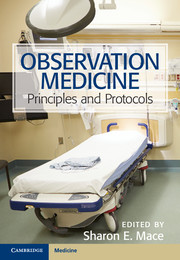Book contents
- Observation Medicine
- Observation Medicine
- Copyright page
- Contents
- Advance Praise
- About the Editors
- Contributors
- Foreword: Onward and Upward
- Preface
- Part I Administration: Key Concepts of Observation Medicine, and Developing and Maintaining an Observation Unit
- Part II Observation Medicine: Clinical Setting and Education
- Part III New Developments in Observation Medicine
- Part IV Clinical
- Part V Financial
- Part VI International
- Part VII Evidence Basis for Observation Medicine
- Chapter 80 The Evidence Basis for Observation Medicine in Adults Based on Diagnosis/Clinical Condition
- Chapter 81 The Evidence Basis for Age-Related Observation Care
- Part VIII Clinical Protocols
- Part IX Administrative Policies
- Part X Order Sets
- Prologue
- Index
- References
Chapter 80 - The Evidence Basis for Observation Medicine in Adults Based on Diagnosis/Clinical Condition
from Part VII - Evidence Basis for Observation Medicine
Published online by Cambridge University Press: 31 March 2017
- Observation Medicine
- Observation Medicine
- Copyright page
- Contents
- Advance Praise
- About the Editors
- Contributors
- Foreword: Onward and Upward
- Preface
- Part I Administration: Key Concepts of Observation Medicine, and Developing and Maintaining an Observation Unit
- Part II Observation Medicine: Clinical Setting and Education
- Part III New Developments in Observation Medicine
- Part IV Clinical
- Part V Financial
- Part VI International
- Part VII Evidence Basis for Observation Medicine
- Chapter 80 The Evidence Basis for Observation Medicine in Adults Based on Diagnosis/Clinical Condition
- Chapter 81 The Evidence Basis for Age-Related Observation Care
- Part VIII Clinical Protocols
- Part IX Administrative Policies
- Part X Order Sets
- Prologue
- Index
- References
Summary
This chapter deals with critical issues in observation medicine for adult patients based on a given diagnosis or clinical condition, such as chest pain or asthma. A separate chapter deals with critical issues in observation medicine based on age, for example, observation medicine for pediatric and geriatric patients. The critical questions addressed in this chapter are:
1: In adult patients, when compared with inpatient treatment does the provision of observation services, specifically in a dedicated, protocol-driven observation unit (OU), improve patient outcomes, decrease length of stay (LOS), reduce costs, increase patient satisfaction, and have other benefits, including (but not limited to) decreased readmissions?
2: In adult patients, does the use of OU clinical and administrative methodology (by aggressive early diagnostic and therapeutic management using tools such as protocol-driven therapy) produce equivalent or better results (e.g., patient outcomes, LOS, costs, and adverse events) compared with routine inpatient care?
3: In the adult emergency department (ED), does use of an OU improve key measures of department efficiency, such as decreases in ED LOS, door-to-doctor time, ambulance diversion, and the left-without-being-seen rate?
- Type
- Chapter
- Information
- Observation MedicinePrinciples and Protocols, pp. 430 - 477Publisher: Cambridge University PressPrint publication year: 2017
References
- 2
- Cited by



